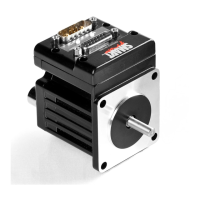Moog Animatics SmartMotor™ Developer's Guide,Rev. L
Page 159 of 909
Electronic Camming Notes and Best Practices
The following are important notes and best practices for electronic camming applications:
l
The first cam point should be CTW(0,0) or CTW(0) variable length or fixed length cam
segment, respectively.
l
It is up to the programmer to pick a repeating cycle of the TMP function (MFA + MFSLEW
+ MFD) that also matches the master length of the table (CTA) as follows.
l
The output of MFA, MFSLEW and MFD are physically executed in sequence. They
DONOT overlap in any way (see the next bullets). Therefore, it may be helpful to
place them in sequence in your program.
l
For simplicity, use MFA(x,1), MFSLEW(y,1), and MFD(z,1), output from TMP
counts, because then: x+y+z = the total distance as input into the cam.
For example, if your cam repeats every 800 input counts, then you must
distribute that 800 counts over the ascend, slew, and descend parts of the TMP.
For an illustration of the parts of the TMP, refer to the Gearing Profile figure on
page 141.
NOTE: DONOTassume that MFSLEW (slew) alone is the total cam
length; it is not!
l
If the application needs to function in terms of input encoder counts (see the
previous figure), then the following transforms must be considered:
TMP ascend and descend relationship is: Output = (Input/2) * (MFMUL/MFDIV)
Slew section is: Output = Input * (MFMUL/MFDIV)
l
As shown in the previous two bullets, MFMUL and MFDIV are imposed on
command(x,0) values. However, note that MFMUL and MFDIV still have an effect
in both modes (i.e., the ratio of input to output counts is still MFMUL/MFDIV). The
difference is the final output value used as the trigger to go to the next phase is
not affected in (x,1) mode.
l
MFSDC takes two arguments. To disable any "repeating" of the TMP function, the
command is MFSDC(-1,0).
NOTE: MFSDC(-1) is seen as an error and won't change the existing setting.
For diagrams of MFSDCsettings and their results, see MFSDCModes on page 145.
However, note that the last mode shown is not for use with cam mode.
l
If no MFSLEW is set (default operation), the ramp function will execute MFA and then
run forever (until X command). Use the command MFSLEW(-1), MFSLEW(-1,0) or
MFSLEW(-1,1) to disable the slew distance (i.e., any of those three forms of MFSLEW
will disable the slew distance).
l Camming with gearing fed into it is the default operation, i.e., camming with gearing of
MFMUL=1, MFDIV=1, the MFA and MFD commands are at 0 distance, and MFSLEW is
ignored. In this default operation, if you issue MC, G commands, the motor starts cam-
ming off of the source SRC(1, or 2) immediately. When a set single shot or repeated
cycle is desired, that is where MFSDC and the other commands come into play, espe-
cially for label feeding, traverse cutting, and similar applications. For an example, refer
to the sample program Camming - Demo XYCircle on page 836.
Part 1: Programming: Electronic Camming Notes and Best Practices

